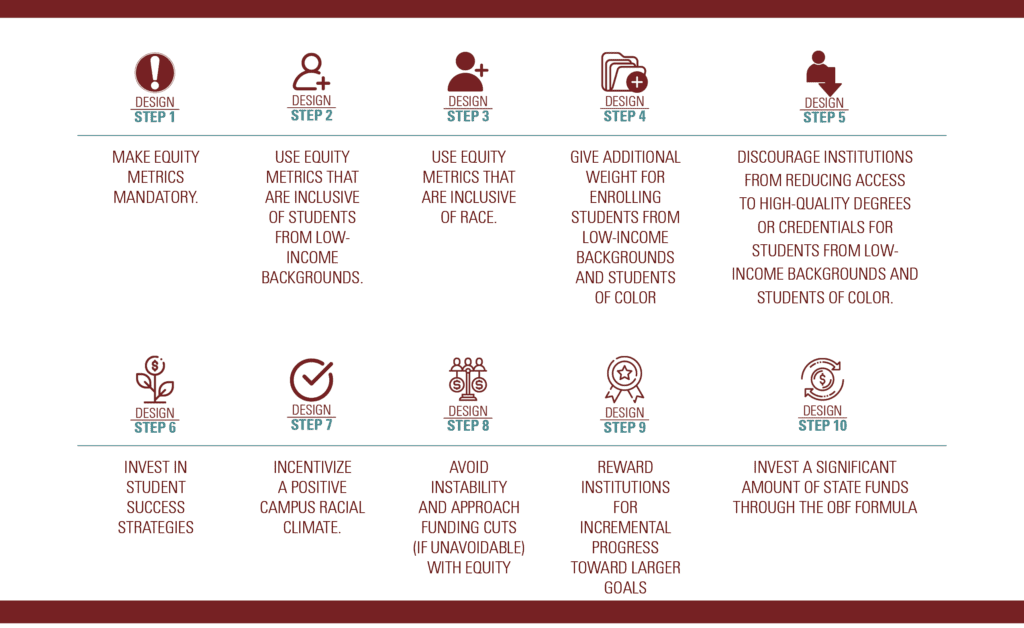Re-Imagining Outcomes-Based Funding
Using Metrics to Foster Higher Education Equity
College students, staff, and faculty all across the country are demanding greater racial and socioeconomic justice in higher education, where longstanding inequities create barriers for students who are Black, Latino, or from low-income backgrounds to earn a postsecondary degree. They join advocates and protestors around the world who are demanding change across sectors — criminal justice, health care, social services, and education — collectively calling for a more just society. In response, policymakers and higher education leaders have made public statements confirming their commitment to racial justice and equity more broadly.
Statements, however, are just a start. What matters most are the policy decisions that directly impact the lives of students of color and students from low-income backgrounds.
One set of policy decisions that higher education advocates are calling into question is how state leaders allocate resources and funds. Re-Imagining Outcomes-Based Funding: Using Metrics to Foster Higher Education Equity analyzes how well existing state policies address equity concerns and makes recommendations for designing and implementing outcomes-based funding (OBF) policies that better advance equity.
The report looks at 33 states that have allocated funding to two-year or four-year public institutions (or both) through at least one OBF policy. Unfortunately, many of these models have done little to improve resource equity or boost student success overall.
Creating Equitable OBF Policies
With the right design and implementation, OBF policies have the potential to be catalysts of equity at the student and institutional levels. To do this, they must
- Recognize the longstanding limitations placed on students of color and students from low-income backgrounds, and on the institutions that enroll the majority of them;
- Consider an institution’s context and award more funding to institutions that have less, so they will be better equipped to support their students;
- Disaggregate metrics by race and ethnicity to highlight inequities; and
- Hold institutions accountable for what happens between enrollment and graduation (and, in some cases, thereafter).
The following design changes to OBF models can also help ensure that institutions are supporting students of color and students from low-income backgrounds holistically:

With these innovative changes, OBF models can ensure that institutions are not just enrolling and graduating students of color and students from low-income backgrounds, but truly supporting them holistically.
It’s time to trade funding models that favor colleges that have traditionally received more than their fair share of resources for an improved approach that fosters racial and economic justice by prioritizing students from low-income backgrounds and students of color and the colleges that are most committed to their success.
Five Steps For OBF Implementation
- Diversify state officer ranks with equity advocates who are people of color and graduates of underrepresented institutions like HBCUs and MSIs.
- Seek the input of institutions that serve students of color and students from low-income backgrounds in OBF design and changes.
- Invest in increasing the capacity of under-resourced institutions.
- Provide technical assistance to better address and plan for equity issues.
- Hold institutions harmless in initial (or transition) years of OBF and match previous-year end funding.
“This is indeed the time for state leaders to act boldly to bring us out of the pandemic better than before. With the right incentives and sufficient support, all public colleges can fulfill their promise to be effective engines of upward mobility for students of color and students from low-income backgrounds.”
– Ted Mitchell, Ph.D., president of the American Council on Education
Five Equity-Focused Metrics in State OBF Policies:
In this report, we examined five kinds of equity-focused metrics in state OBF policies to determine the extent to which states prioritize the enrollment and success of students of color and students from low-income backgrounds:

While the inclusion of these metrics in policies is essential, how they are deployed is equally as important. Therefore, we also considered whether the metrics were mandatory, optional, or weighted. Weighted metrics are ideal. These are mandatory and are given additional value, so strong institutional performance on a weighted metric would garner greater advantage or funding.

